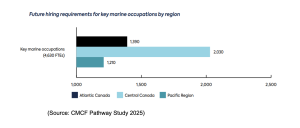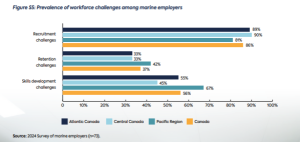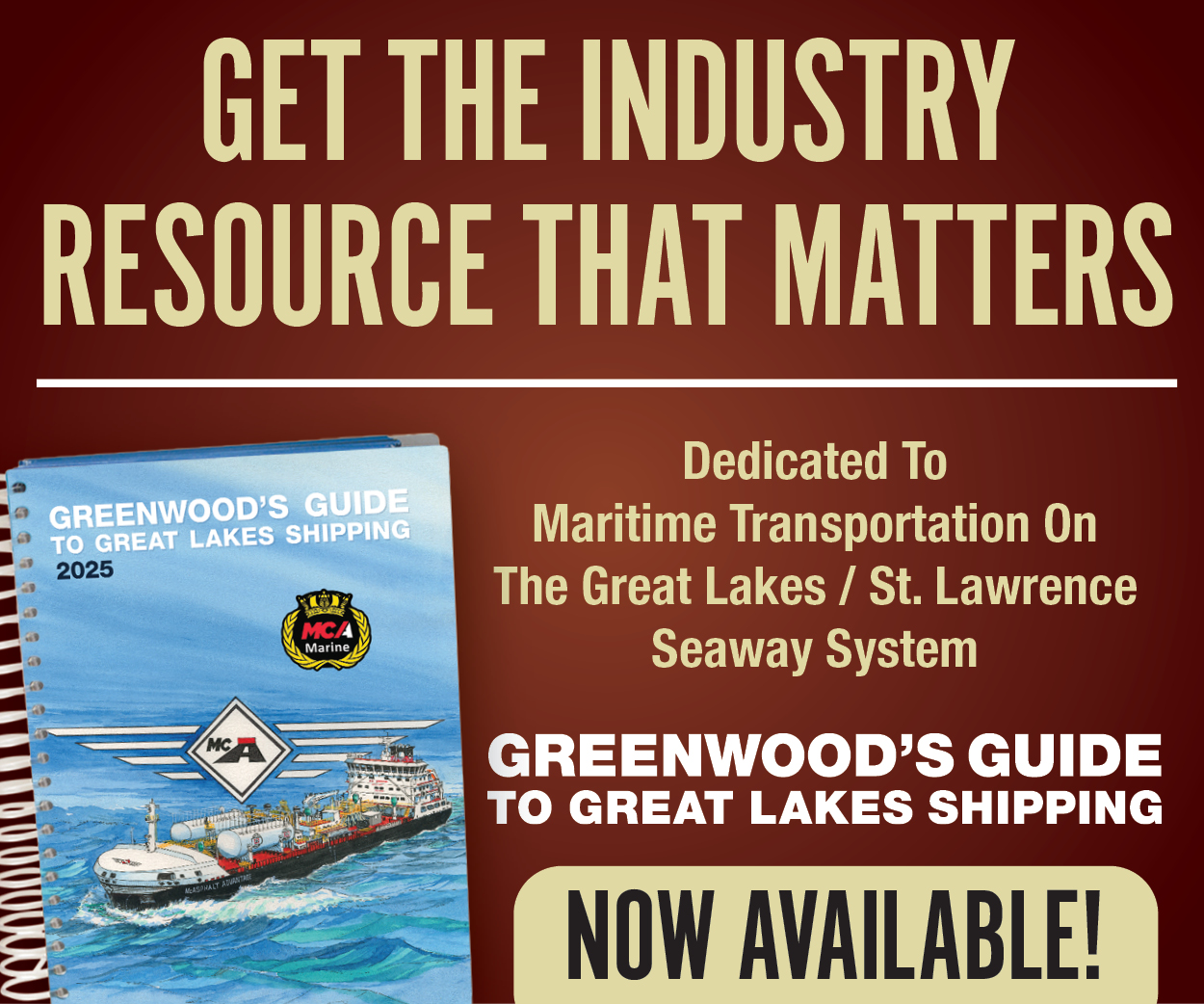CMCF Study Addresses How to Retain and Train a New Workforce
CMCF calls the 92-page study a “first of its kind” report, a comprehensive and detailed study that breaks out challenges with recruitment, retention and training and skills development. The study was researched and written by Canadian research and consulting company Malatest. A study advisory group provided guidance and help validating research findings. The group included the Canadian Coast Guard, the Canadian Ferry Association, ILWU Local 400 Marine Section and General Workers and the Pacific Pilotage Authority, among others. Many of these same organizations helped to fund the study.
Finding People
According to the study, a lack of awareness about marine opportunities is one of several challenges
facing the maritime industry. Almost half of working-age Canadians have not heard about marine careers. The study authors stated that “almost every stakeholder indicated that the sector has historically underinvested in outreach and marketing.”
Negative perception of working conditions is another cause for concern. Many younger workers are averse to being away from home and family. “A third of students and recent graduates,” the study noted, “anticipated that long periods at sea were going to be a challenge in their marine career.” Wi-Fi is more common these days, but the study reported that it’s not available on all vessels in Canada.
Some vessels reportedly have poor accommodations, and crews on some vessels share cabins or beds. The study reported that traditional seafaring roles do not match young people’s career expectations.
A high cost of living is also a contributing factor. British Columbia is cited as one region where a high cost of living challenges employers’ recruitment efforts. The Canadian Coast Guard reports difficulty in attracting workers to such locations and that employees often seek transfers elsewhere.
The study also looked at why marine careers are attractive. Strengths included a personal interest in marine training and related issues, career opportunities and job stability, finances and financial incentives and a family background in maritime issues. 
Keeping People
Employee retention continues to be a common problem within the industry. The study suggested enhancing compensation with financial rewards for time at sea to encourage mariners to stay and progress within their careers. It’s noted that this is particularly important for the Canadian Coast Guard.
Another suggestion is to evaluate how issues of bullying and harassment are handled. Employers need to demand that it’s everyone’s responsibility to stamp out corrosive attitudes and behaviors.
Longer term ideas seek improved onboard living experiences and connectivity at sea. And the study – in numerous places – called for policies that make it easier for women to succeed in maritime careers. One suggestion is for Transport Canada to revise its maternity leave policies regarding sea time and certification retention. This would help keep women seafarers. “Workplace culture can be challenging,” the study highlighted, “especially for women.”
Training and Skills Development
The study found that the capacity of education and training systems is insufficient to meet the growing demand for seafarers. The study found that the educational system was not operating at its full capacity, with significant variation by educational institution and program and by region.
The study suggested a few ideas to improve education and training.
- Greater investment in financial aid, such as grants, scholarships and tuition subsidies
- Industry stakeholders could increase funding for scholarships and bursaries for marine officer cadets. The authors suggested a need to “improve sector-wide promotion and coordination of these resources.”
- One longer term idea is to conduct a research project to evaluate the feasibility and process required to obtain skilled trades recognition for specific mariner positions.
Series of Recommendations
The study suggested that Canada’s governments could help with workforce challenges. With training, for example, it’s suggested that Transport Canada, Employment and Social Development Canada and provincial governments increase support for marine education. Another suggestion is for federal and provincial governments to increase availability of remote, intensive, hybrid and simulation learning within marine training programs to help reduce geographical, financial and time barriers for people who do not live close to training institutions or who must juggle other responsibilities. These changes would require approval by Transport Canada.
In March 2023, the House of Commons released the report “Addressing Labour Shortages in the Canadian Transportation Sector,” issued by the Standing Committee on Transport, Infrastructure and Communities, chaired by MP Peter Schiefke.
The report listed 15 recommendations – not just for the maritime sector but ideas that could help across transportation, from truck drivers to airline pilots.
Some of the recommendations align with CMCF’s report, such as streamlining visa and work permit processing for foreign workers and collaboration to align training programs and funding and “to establish programs aimed to standardize professional designations and ensure their transferability across Canada.”
Two recommendations focus solely on maritime workers.
- That the government of Canada review legislation to facilitate the hiring of foreign workers having studied in the country, especially in the marine sector
- That the government of Canada, respecting provincial and territorial jurisdictions, work with partners to increase marine learning capacity and consider providing learning centers in strategic areas where entry level and refresher courses could be offered.
In September 2023, in a response to the House of Commons report, the government expressed support for many recommendations. It noted cross-country reciprocal agreements allowing seafarers with certificates to apply for Canadian endorsement. Another example is education support. In 2023, the government provided an investment of $29.8 million to extend the Marine Training Program for another four years. This program has a focus on expanding opportunities for underrepresented groups, including Indigenous peoples, Arctic communities and women.
A Shared Responsibility
Transport Canada is responsible for labor-related oversight concerning safety and operational standards across federally regulated Canadian transportation modes and is a founding member of the Canadian Marine Careers Foundation (CMCF). Following the release of the CMCF workforce report, the department announced several initiatives that align with strengthening the marine workforce.
- Launching a Fatigue Management at Sea course under the Seafarer Certification Program
- Publishing a standard for online and blended learning at approved maritime institutions
- Advancing proposed changes to the Marine Personnel Regulations, 2025, which would modernize training, certification, labor standards, and the Marine Medical Program.
Transport Canada continues to address labor and supply chain challenges in the marine sector through several recent initiatives.
- Investment of $58 million since 2017 in the Marine Training Program under the Oceans Protection Plan: This program partners with four training institutions to deliver courses to underrepresented groups—including Indigenous peoples, coastal communities and women—resulting in more than 700 graduates now working across the marine sector.
- Department of National Defense Equivalency Program: Supports the transition of retired naval veterans into commercial marine careers;
- Reciprocal arrangements with Ireland, Brunei Darussalam and Belgium: Enable qualified foreign seafarers to work on Canadian-flagged vessels.
- Collaboration with the CMCF: Aims to build a skilled, diverse and future-ready marine workforce.
- Direct Examination (Entry) Program: Designed for seafarers seeking permanent residency in Canada through Immigration, Refugee and Citizenship Canada.
- Approval of 20 registered seafarer recruitment companies: These companies are authorized to place qualified Canadian seafarers on Canadian vessels.
Transport Canada states that building a future-ready workforce and addressing rising job vacancy rates is a shared responsibility among industry, all levels of Canadian government and education and training institutions. These efforts reflect ongoing collaboration with partners like the CMCF to build a skilled, diverse and future-ready marine workforce.
Need for Competitive Wages
In 2024, a U.S. Congressional Research Service (CRS) official wrote that starting wages for shipyard work were no longer competitive enough compared to less dangerous and more predictable shore-side work, even compared to fast food restaurants. This contrasts with comments from maritime employers who assert that their starting wages are generous.
In CMFC’s study, employers and students have different views about wages and salaries. For employers, wages and salaries are not among the top concerns for recruitment or worker retention.
Educational and industry representatives quoted in the study commented that maritime wages are competitive, although there are concerns about recent cost of living increases. The CMCF study suggested that higher wages would help retain seafarers in the public sector.
In contrast, for maritime students, wages and benefits are a top issue, behind seagoing personal difficulties and being tired.
The American Waterways Operators was asked whether companies are taking a new look at employee compensation, particularly considering CRC’s comments. A spokesperson replied that “AWO members prioritize offering competitive pay to attract job seekers to the maritime industry” and that compensation is evaluated regularly. AWO said companies seek a pay scale that “ensures that their mariners can comfortably support themselves and their families.”
A spokesperson for one Great Lakes shipping company said that their entry-level applications are strong, that they “have a steady influx of people interested in working for us.” A bigger challenge is with licensed mariners and competition from other Great Lakes and ocean carriers.
This person added, however, that “we do need to be aware of external pay scales outside of our industry because they challenge our candidate pipeline. But we believe our overall benefits—including company-sponsored pathways and unlimited opportunities for advancement—help us in our competition for talent.”
Leadership Insights
CMCF Executive Director Julia Fields said the new study establishes a compelling, data-based case for a national maritime skills strategy. A move at the federal level could be complemented by provincial governments that have maritime strategies, such as Ontario and the Atlantic provinces.

This approach, she said, would help close systematic gaps and barriers and help implement the study’s recommendations. Fields said that working on support for a strategic approach, among many players, “will be a key CMCF activity this autumn.” A focus will be on streamlining training pathways, improving student access and funding and expanding support among underrepresented groups.
The workforce study points out that Canada’s maritime institutes are not working at capacity now. They need more students. Fields said that enrollment in maritime education is improving, and that all the attention it’s getting is starting to pay off. She added, though, that challenges extend beyond an attraction issue. There are structural barriers. For example, in-person training means that students must pay for tuition and housing near a campus. Schools must maintain, upgrade and replace expensive simulators and equipment. “With the right resources, such as dedicated outreach and better financing, maritime schools could do much more to attract and retain talent,” she said.
Hybrid, remote and intensive training models provide new opportunities, helping to increase access to at-sea training. Schools will need to address a shortage of qualified instructors in order to handle an increase in students.
Fields noted optimism on several fronts, including an increase in participation by women and indigenous peoples, a testament, she said to “focused outreach and evolving industry culture.” She also pointed to the success of focused events, such as
CMCF’s “Marine Month in Canada,” which reached thousands of students, showing a measurable boost in career awareness. “The study itself also provides detailed, evidence-based data, providing a solid platform to present to government and stakeholders,” she said. “This is a true call to action for more investment and the development of a comprehensive national maritime skills strategy.”
Study Statistics
- 86% of employers say they are struggling to recruit candidates because of two troublesome factors: (1) too few applicants and (2) those applicants are not qualified enough.
- The overall sector job vacancy rate is 11%, more than three times higher than the national average for the transportation and warehouse sector.
- Maritime employers need an additional 8,300 new full-time equivalent employees over the next five years to meet industry growth, to replace retirees and to counter turnover. That number is more than 30% of the current seafaring workforce of 28,500 people. The Pacific region will account for 64% of future requirements for all occupations.
- More than half (56%) of the 8,300 positions are for skilled occupations that are federally regulated and critical to vessel operation. The central region (Ontario/Quebec) will account for 44% of these key positions; followed by Atlantic (30%) and Pacific (26%) regions.

HOPA Ports Seeks to Build New Port at Sault Ste. Marie
In September, the Hamilton Oshawa Port Authority (HOPA) and the city of Sault Ste. Marie, Ontario, announced a partnership to develop a multimodal port and trade corridor connecting northern Ontario... Read More

Alliance for the Great Lakes Addresses the Impact of Data Centers
The Alliance for the Great Lakes (AGL), a nonpartisan, nonprofit organization that works to protect, conserve and restore the Great Lakes, is investigating the impact of data centers and agricultural... Read More


